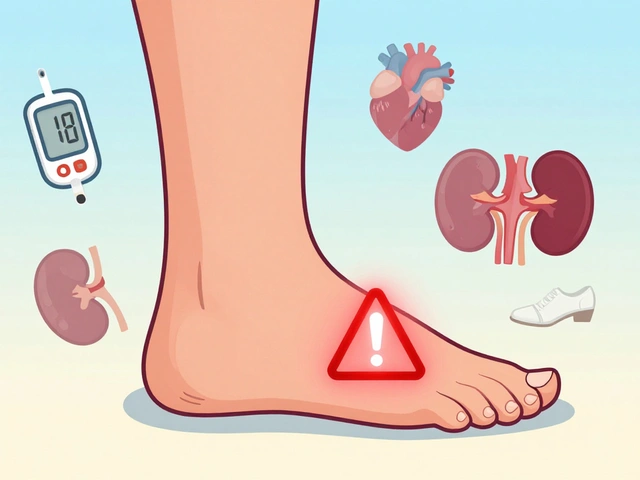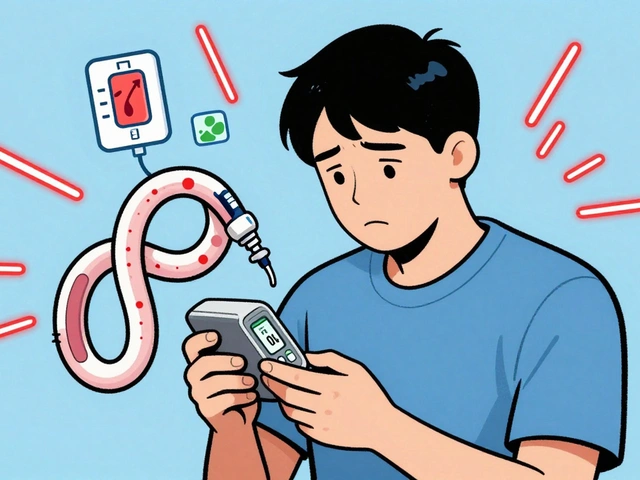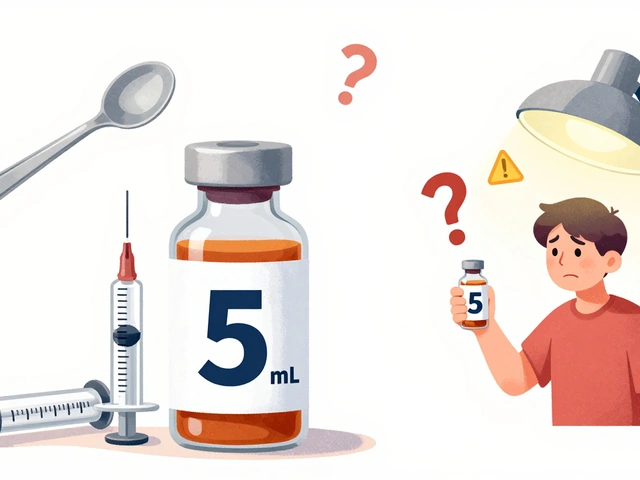
Choosing the Right Power for Your Hearing Aid
If you wear hearing aids, you’ve probably faced the same question: disposable batteries or rechargeable? It’s not just about convenience-it’s about your daily life, your hands, your budget, and even the environment. For years, disposable zinc-air batteries were the only option. Now, rechargeable models are everywhere. But that doesn’t mean one is better for everyone.
Let’s cut through the noise. This isn’t about which tech is newer or trendier. It’s about what actually fits your routine, your body, and your world.
How Disposable Hearing Aid Batteries Work
Disposable hearing aid batteries are small, zinc-air cells that start working when you pull off the tab. They come in four standard sizes: Size 10 (yellow), Size 312 (brown), Size 13 (orange), and Size 675 (blue). Each size matches a specific hearing aid model based on power needs.
On average, a single battery lasts between 5 and 16 days, depending on how much you use your hearing aids. If you’re in loud environments, streaming audio, or using Bluetooth features, you’ll drain them faster. A typical user goes through 24 to 30 batteries a year-sometimes more.
They cost about $6 to $9 for a pack of six. That might seem cheap, but over time, it adds up. For someone using two hearing aids, that’s $30 to $150 a year just on batteries. No hidden fees, no charger to buy-but you’re always buying more.
The Rise of Rechargeable Hearing Aids
Rechargeable hearing aids now make up about 65% of new devices sold in North America. They use built-in lithium-ion batteries, the same kind you find in smartphones. Most models give you 24 hours of use on a full charge, and some can get 8 hours of power from just 30 minutes of charging.
You charge them overnight in a small dock, just like your wireless earbuds. No fumbling with tiny tabs. No need to carry extra batteries. You just pop them in the case before bed and wake up to fully powered hearing aids.
The catch? These batteries don’t last forever. After 300 to 500 charges-roughly 1 to 1.5 years-they start losing capacity. At that point, you need to take them to an audiologist for replacement. That costs between $100 and $200, depending on the brand. But until then, you’re not buying new batteries every few weeks.
Pros of Disposable Batteries
- Always ready-if your battery dies mid-day, you can swap it in seconds. No waiting. No charger needed.
- Perfect for travel-carry a small pack of 10 spares in your wallet. No outlet? No problem. You can use them anywhere, even on a remote hike or international flight.
- Compatible with every style-including the smallest completely-in-canal (CIC) models. Rechargeables can’t fit in these tiny devices.
- No tech to break-no charging ports, no circuitry, no software glitches. Just a battery. Simple.
People who travel often, live in areas with unreliable power, or just hate relying on electronics swear by disposables. One user on Reddit said, “I’m out hiking for a week. I’ve got 12 batteries in my pocket. That’s peace of mind.”
Pros of Rechargeable Hearing Aids
- No more tiny battery changes-if you have arthritis, shaky hands, or trouble seeing small things, this is a game-changer. You don’t have to twist, pull, or push anything. Just drop them in the charger.
- Lower long-term cost-after 18 to 24 months, you’re saving money. No more buying $8 packs every few months. The upfront cost is higher, but the yearly expense drops sharply.
- More consistent sound-zinc-air batteries lose power slowly. As they drain, your hearing aid gets quieter. Rechargeables keep steady voltage until they’re empty, so your sound quality doesn’t fade.
- Less waste-each user throws away 100 to 200 disposable batteries a year. Rechargeables cut that to one or two replacements every couple of years. In the U.S. alone, this shift prevents over a million pounds of battery waste annually.
For users over 65, especially those with joint pain, the shift to rechargeables isn’t just convenient-it’s life-changing. One survey found 78% fewer battery-related frustrations after switching.
When Rechargeables Fall Short
Rechargeables aren’t perfect. Here’s where they struggle:
- Charging takes time-if you forget to charge them overnight and your hearing aids die during the day, you’re stuck for hours. No quick swap.
- They can fail-the charging dock, the battery, or the internal circuit can break. Unlike a disposable battery, you can’t just buy a replacement at the pharmacy.
- Not for everyone-CIC hearing aids can’t use rechargeable batteries. If your hearing loss requires the smallest device, you’re locked into disposables.
- Travel risks-if you’re flying or staying somewhere without power, you’re vulnerable. Some people carry a spare set of disposables just in case.
Consumer Reports found rechargeables scored lower on reliability than disposables. Users reported charging failures, dock malfunctions, and sudden power loss. For people who depend on hearing aids for safety-like crossing streets or hearing alarms-that’s a real concern.
Cost Comparison: Upfront vs. Long-Term
| Cost Factor | Disposable Batteries | Rechargeable System |
|---|---|---|
| Initial Device Cost | Same as rechargeable models | Same as disposable models |
| Charger Cost | $0 | $50-$150 (often included) |
| Annual Battery Cost | $30-$150 | $0 (for first 1-1.5 years) |
| Battery Replacement Cost | None | $100-$200 every 1-1.5 years |
| Break-Even Point | N/A | 18-24 months |
After two years, most users save money with rechargeables. But if you only use your hearing aids a few hours a day, or you replace your aids every 3-5 years, disposables might still be cheaper overall.
Who Should Stick With Disposable Batteries?
You might be better off with disposables if:
- You wear completely-in-canal (CIC) hearing aids
- You travel often and can’t rely on consistent power
- You have trouble remembering routines (like charging every night)
- You live in a climate with extreme heat or cold-some rechargeable batteries lose power faster in freezing temperatures
- You’re on a tight budget and can’t afford the upfront cost of a rechargeable system
One audiologist in Perth told me, “I have a patient who goes bushwalking every weekend. He carries 15 spare batteries. He won’t switch. He’s not tech-savvy, and he doesn’t want to risk being silent in the middle of nowhere.”
Who Should Switch to Rechargeable?
Rechargeables are ideal if:
- You have arthritis, Parkinson’s, or other dexterity issues
- You use your hearing aids 12+ hours a day
- You’re okay with a nightly routine (plugging them in before bed)
- You care about reducing waste
- You don’t travel often or can carry a backup set of disposables
Users over 65 are the biggest adopters. On Reddit, 68% of users over 65 prefer rechargeables. For younger users, it’s closer to 52%. The difference? Hands. Older users often struggle with fine motor skills. Rechargeables remove that barrier entirely.
Real-World Tips for Both Systems
Whether you use disposables or rechargeables, here’s what actually helps:
- For disposables: Keep at least a 30-day supply on hand. Store them in a cool, dry place-heat and humidity kill battery life. Don’t remove the tab until you’re ready to use it.
- For rechargeables: Charge them every night. Don’t wait until they’re dead. Lithium-ion batteries last longer when they’re not fully drained. Keep the charging dock clean-dust and earwax can block contacts.
- For both: Always carry a spare. Even if you’re 99% sure your battery is good, have a backup. Hearing loss can be dangerous in emergencies.
The Future Is Charging-But Not Everywhere
The market is shifting fast. In 2018, only 28% of new hearing aids were rechargeable. By 2023, that jumped to 72%. Experts predict 85% will be rechargeable by 2027. New tech is coming: solid-state batteries that last 48 hours, wireless charging docks, and even hybrid models that let you swap in a rechargeable micro-battery.
But that doesn’t mean disposables are disappearing. They’ll still be needed for CIC aids, travelers, and people who want zero tech complexity. The future isn’t one or the other-it’s choice.
What Should You Do?
Ask yourself:
- Do I struggle to change small batteries?
- Do I travel often or live somewhere with unreliable power?
- Am I okay with charging every night?
- Do I want to reduce my environmental footprint?
- What kind of hearing aid do I have?
There’s no right answer for everyone. But there’s a right answer for you. Talk to your audiologist. Try both if you can. Don’t let marketing push you into something that doesn’t fit your life.
Your hearing matters. Your power source should make life easier-not harder.
Can I use rechargeable batteries in any hearing aid?
No. Rechargeable systems only work in certain hearing aid styles-mostly behind-the-ear (BTE), receiver-in-canal (RIC), and some in-the-ear (ITE) models. Completely-in-canal (CIC) hearing aids are too small to fit a rechargeable battery. If your device is tiny and fits deep in your ear canal, you’re stuck with disposable batteries.
How long do rechargeable hearing aid batteries last before needing replacement?
Most lithium-ion batteries in hearing aids last 300 to 500 full charge cycles. That’s about 1 to 1.5 years of daily use. After that, they hold less charge-often below 80% of their original capacity. When you notice your hearing aids don’t last all day anymore, even after a full charge, it’s time for a professional battery replacement.
Are disposable hearing aid batteries bad for the environment?
Yes, but not because they contain mercury-that was removed years ago. They still contain zinc and manganese, which can leach into soil and water if thrown in regular trash. In 38 U.S. states, they must be recycled separately. Rechargeables reduce this waste dramatically-users go from discarding 100-200 batteries a year to replacing one battery every 1-2 years.
What should I do if my rechargeable hearing aid stops charging?
First, check the charging dock. Clean the contacts with a dry cloth-earwax buildup is the most common cause. Try a different outlet. If it still doesn’t work, try inserting a fresh set of disposable batteries (if your model allows it) to confirm the hearing aids still work. If they do, the issue is likely the battery or charger. Contact your audiologist or the manufacturer-they often cover replacement under warranty for the first 1-2 years.
Can I carry spare rechargeable batteries for my hearing aids?
No. Rechargeable hearing aids have built-in, non-removable batteries. You can’t swap them out like disposables. That’s why many users who rely on rechargeables still carry a spare set of disposable batteries and a basic hearing aid as a backup-especially when traveling.
Do rechargeable hearing aids work in cold weather?
Some older models struggled in freezing temperatures, but newer ones like Widex’s Evoke CR can maintain 95% capacity between 32°F and 104°F. If you live in a cold climate, ask your audiologist about temperature-resistant models. Always keep your hearing aids in your pocket or case when outside-not in a bag where they can get too cold.
Final Thought: It’s About Your Life, Not the Tech
The best hearing aid power system is the one you’ll actually use. If you’re constantly forgetting to charge, you’ll end up with dead hearing aids. If you’re struggling to change batteries, you’ll avoid wearing them. Neither outcome helps your hearing-or your quality of life.
There’s no shame in sticking with disposables. There’s also no shame in switching to rechargeables. The goal isn’t to follow trends. It’s to hear better, every day, without stress.






13 Comments
I've been using disposables for 8 years. Just pop in a new one when it dies. No charging, no drama. I carry 10 in my wallet. If my hearing aids die mid-hike, I'm not stuck. Simple works.
Rechargeables? Cool tech. But I'm not a gadget guy.
Let me tell you something nobody wants to admit - rechargeables are just another way for the hearing aid industry to lock you in. You buy the device, then you’re forced to pay $150 every year to replace a battery they won’t let you swap yourself. It’s planned obsolescence dressed up as ‘convenience.’
And don’t get me started on the charging docks. One drop of earwax and suddenly you’re deaf for 48 hours. Who designed this? A toddler?
I switched to rechargeables last year after my hands started shaking. It’s been life-changing. No more fumbling with those tiny tabs. I used to cry trying to change them. Now I just drop them in the case before bed. It’s quiet. It’s easy. I didn’t think something so small would make me feel so independent again.
In India, many of us still use disposables not because we prefer them - but because rechargeables are too expensive. A single replacement battery costs more than a week’s lunch for some. The tech is great, but access isn’t equal. We need affordable options, not just shiny new gadgets for the rich.
Also - have you seen how many people just throw old batteries in the trash? No recycling bins here. So yes, disposables are bad for the planet - but so is ignoring the poor.
I’ve been watching this transition closely. The FDA hasn’t mandated any safety testing for lithium-ion batteries in hearing aids. None. Zero. And yet we’re told they’re ‘safe.’ Meanwhile, the same companies that sell you rechargeables also own the recycling centers that charge you $20 to dispose of your old batteries. Coincidence? I think not.
They want you dependent. They want you locked in. And they want your data - your usage patterns, your sleep hours, your location - all logged through the app.
To anyone considering switching: don’t rush. Try both. Borrow a friend’s rechargeable system for a week. See how it feels. Don’t let marketing tell you what’s best. Your life, your hearing, your hands - those are the real deciding factors. I switched after 12 years of disposables… and I’m so glad I did. But it wasn’t because it was trendy. It was because it fit me.
OMG I just switched to rechargeables and I can’t believe I waited this long. I used to lose batteries in the couch. Like, literally. One time I had to dig through my entire laundry basket. Now I just drop them in the case and forget about it. I’m not even mad anymore. I’m just… free.
Rechargeables are a scam. The lithium ion batteries? They’re made in China with child labor. The charging docks? They’re full of tracking chips. And the ‘1.5 year lifespan’? That’s not a limit - that’s a countdown to you buying a whole new device. The hearing aid companies are working with the government to phase out disposables. You think it’s about convenience? No. It’s about control.
The environmental argument is statistically misleading. Zinc-air batteries are 98% recyclable - if you use a certified facility. Rechargeable lithium-ion batteries? They’re classified as hazardous waste. One failed cell can ignite a whole charging dock. And the rare earth minerals? Mining them destroys ecosystems. You’re trading one environmental cost for another - and the second one is far more dangerous.
Also, the ‘100+ batteries a year’ claim? That’s based on 16-hour daily use. Most people wear them 6-8 hours. That’s 20-30 batteries. Not 150.
Bro, I switched to rechargeables after my mom had a stroke and lost fine motor control. She couldn’t hold a battery for 2 seconds. Now she just drops them in the charger. No tears. No stress. No one has to help her. I cried when I saw her smile because she could hear the birds again - without needing someone to change her battery.
It’s not about tech. It’s about dignity.
Disposables are cheaper. Period. Rechargeables cost more upfront, cost more to replace, and break more often. If you’re not using your aids 12+ hours a day, you’re wasting money. And if you forget to charge? You’re silent. That’s not convenience. That’s risk.
It’s funny how we treat hearing aids like phones. We want the newest model, the fastest charge, the brightest screen. But hearing isn’t a trend. It’s a need. The best system isn’t the one with the most features - it’s the one you’ll actually use. If you hate charging, stick with disposables. If you hate changing batteries, go rechargeable. Neither is better. Both are just tools. Use the one that lets you hear - without fighting.
I’m 72. I’ve used disposables since 1998. Last month, my hands got so stiff I couldn’t open the battery compartment. My daughter bought me a rechargeable pair. I was angry. I didn’t want to ‘learn tech.’ But now? I charge them every night like brushing my teeth. I don’t think about it. I just… hear. And I don’t miss a single bird song. I didn’t know I was missing them until I could hear them again. Thank you for writing this. It’s not about batteries. It’s about being present.